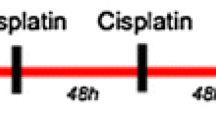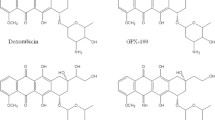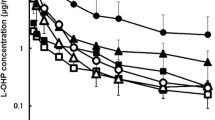Summary
4-(2-sulfonatoethylthio)-cyclophosphamide cyclohexylamine salt (AZ; ASTA Z 7557) is a cyclophosphamide (CP) analog designed to be without acute bladder toxicity and to undergo spontaneous activation yielding phosphoramide mustard (PM). Studies in murine systems with intraperitoneal (i.p.) administration suggest that AZ may have a therapeutic index favorable to CP without an associated risk of bladder toxicity. Pericapsular hepatic fibrosis after i.p. administration suggests that regional AZ therapy may cause local toxicity. Further study of this compound, especially with intravenous (i.v.) administration, will be of interest.
Similar content being viewed by others
References
Colvin M: The alkylating agents. In B Chabner (ed): Pharmacologic Principles of Cancer Treatment. W.B. Saunders Company, Philadelphia, 1982, pp 287–288
Takamiza A, Matsumoto S, Inata T, Katagiri K, Tochino Y, Yamaguchi K: Studies on cyclophosphamide metabolites and their related compounds. II. Preparation of an activated species of cyclophosphamide and some related compounds. J Am Chem Soc 95:985–986, 1973
Ramonas LM, Erickson LC, Ringsdorf H, Zaharko DS: Effect of dose, schedule and route of administration on the in vivo toxicity and antitumor activity of two activated sulfhydryl derivatives of cyclophosphamide. Cancer Res 40:3704–3708, 1980
Brock N, Steker J, Pohl J, Niemeyer U, Scheffler G: Acrolein, the causative factor of urotoxic side-effects of cyclophosphamide, ifosfamide, trofosphamide, and sufosfamide. Arzneim-Forsch 29:659–661, 1979
Cox PJ, Abel G: Cyclophosphamide cystitis — identification of acrolein as the causative agent. Biochem Pharmacol 28:2045–2049, 1979
Tolley DA: The effect of N-acetylcysteine on cyclophosphamide cystitis. Br J Urol 49:659–661, 1977
Cox PJ, Abel G: Cyclophosphamide cystitis — studies aimed at its minimization. Biochem Pharmacol 28:3499–3502, 1979
Hacker MP, Ershler WB, Newman RA, Gamelli RL: Effect of disulfiram (tetraethylthiuran disulfide) and diethyldithio-carbanate on the bladder toxicity and antitumor activity of cyclophosphamide in mice. Cancer Res 42:4490–4494, 1982
Kedar A, Simpson CL, Williams P, Moore R, Tritsch G, Murphy GP: The prevention of cyclophosphamide induced bladder swelling in the rat by i.v. administration of sodium-2-mercaptoethane sulfate. Res Comm Chem Pathol Pharmacol 29:339–348, 1980
Johnson WW, Meadows DC: Urinary bladder fibrosis and telangiectasia associated with long-term cyclophosphamide therapy. N Engl J Med 294:290–294, 1976
Wall RL, Clausen KP: Carcinoma of the urinary bladder in patients receiving cyclophosphamide. N Engl J Med 293:271–273, 1976
Avery TL, Roberts D, Price RA: Delayed toxicity of 4′ -dimethylepipodophyllotoxin (9-(4,6-0-2-thenylidine-β-D-glucopyranoside) (NSC-122819; VM-26) in mice. Cancer Chemother Rep 57:165–173
Saul G, Matthias M, Rose H, Pradel I: Excretion patterns of alkylating metabolites in urine following cyclophosphamide treatment of tumor patients: Influence of application route, dosage, liver and kidney function. Cancer Res Clin Oncol 94:277–286, 1979
Author information
Authors and Affiliations
Rights and permissions
About this article
Cite this article
Roberts, J.D., Hacker, M.P., Newman, R.A. et al. Efficacy and toxicity of 4-(2-sulfonatoethylthio)-cyclophosphamide cyclohexylamine salt (ASTA Z 7557, INN mafosfamide) after intraperitoneal administration to mice. Invest New Drugs 2, 215–220 (1984). https://doi.org/10.1007/BF00232354
Issue Date:
DOI: https://doi.org/10.1007/BF00232354




